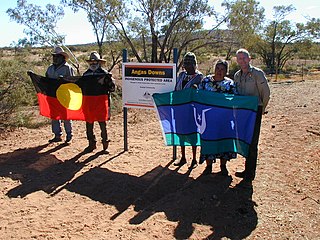
The Pitjantjatjara are an Aboriginal people of the Central Australian desert near Uluru. They are closely related to the Yankunytjatjara and Ngaanyatjarra and their languages are, to a large extent, mutually intelligible.

Mutitjulu is an Aboriginal Australian community in the Northern Territory of Australia located at the eastern end of Uluṟu. It is named after a knee-shaped water-filled rock hole at the base of Uluṟu, and is located in the Uluṟu-Kata Tjuṯa National Park. Its people are traditional owners and joint managers of the park with Parks Australia. At the 2011 census, Mutitjulu had a population of 296, of which 218 (71.2%) were Aboriginal.

Aṉangu is the name used by members of several Aboriginal Australian groups, roughly approximate to the Western Desert cultural bloc, to describe themselves. The term, which embraces several distinct "tribes" or peoples, in particular the Ngaanyatjarra, Pitjantjatjara and Yankunytjatjara groups, is pronounced with the stress on the first syllable: [ˈaɳaŋʊ].
Kalka is an Aboriginal community in the Anangu Pitjantjatjara Yankunytjatjara Lands in South Australia administered under the Anangu Pitjantjatjara Yankunytjatjara Land Rights Act 1981.

Aṉangu Pitjantjatjara Yankunytjatjara, also known as APY, APY Lands or the Lands, is a large, sparsely-populated local government area (LGA) for Aboriginal people, located in the remote north west of South Australia. Some of the aṉangu (people) of the Western Desert cultural bloc, in particular Pitjantjatjara, Yankunytjatjara and Ngaanyatjarra peoples, inhabit the Lands.

Amata is an Aboriginal community in the Anangu Pitjantjatjara Yankunytjatjara Lands in South Australia, comprising one of the six main communities on "The Lands".
Mimili is an Aboriginal community in the Anangu Pitjantjatjara Yankunytjatjara Lands in South Australia, comprising one of the six main communities on "The Lands". At the 2016 Australian census, Mimili had a population of 243.
Pipalyatjara is an Aboriginal community in the Anangu Pitjantjatjara Yankunytjatjara Lands in South Australia, comprising one of the six main communities on "The Lands". At the 2016 census, Pipalyatjara had a population of 189. The residents are mainly Anangu who speak Pitjantjatjara as their first language.
Umuwa is an Aboriginal community in Anangu Pitjantjatjara Yankunytjatjara in South Australia, serving as an administrative centre for the six main communities on "The Lands", as well as the outlying communities.
Pukatja is an Aboriginal community in the Anangu Pitjantjatjara Yankunytjatjara Lands in South Australia, comprising one of the six main communities on "The Lands".
Indulkana is an Aboriginal community in the Anangu Pitjantjatjara Yankunytjatjara Lands in South Australia, comprising one of the six main communities on "The Lands". At the 2016 Australian census, Indulkana had a population of 256.

Watarru Community is an Aboriginal community in the Anangu Pitjantjatjara Yankunytjatjara (APY) lands in South Australia. Watarru Community sits at the foot of Mount Lindsay and the community has at times been known as "Mount Lindsay".
Mintabie is an opal mining community in the Anangu Pitjantjatjara Yankunytjatjara in South Australia. It was unique in comparison to other communities situated in the APY Lands, in that its residents were largely not of Aboriginal Australian origin, and the land had been leased to the Government of South Australia for opal mining purposes since the 1980s.

The Anangu Pitjantjatjara Yankunytjatjara Land Rights Act 1981 grants certain land and other rights to the Anangu Pitjantjatjara Yankunytjatjara in South Australia. It began its life as the Pitjantjatjara Land Rights Act and commenced operation on 2 October 1981. Its long name title is "An Act to provide for the vesting of title to certain lands in the people known as Anangu Pitjantjatjara Yankunytjatjara; and for other purposes". The Act has since had several amendments, the latest in 2017.
Kanyini is a 2006 Australian documentary film, created by Uncle Bob Randall. His dream was to create a film that supported his Kanyini teachings. He approached Melanie Hogan to produce it with him. She directed, filmed and edited the film with the help of Martin Lee whose filming of Uncle Bob Randall's interview made the core thread of the story. The film explores the Kanyini philosophy and the life of Bob Randall, Aboriginal elder, songman and storyteller who lived in Mutitjulu, a town beside the world's greatest monolith, Uluru, in Central Australia. Bob Randall was a 'Tjilpi' of the Yankunytjatjara people and a member of the Stolen Generations.

Angas Downs Indigenous Protected Area (IPA) is an Aboriginal Australian-owned 320,500-hectare (1,237 sq mi) pastoral lease, within the MacDonnell Shire area, 300 kilometres (190 mi) south-west of Alice Springs, Northern Territory, 135 kilometres (84 mi) east from Uluṟu-Kata Tjuṯa National Park, 100 kilometres (62 mi) south-east of Kings Canyon/Watarrka National Park and 40 kilometres (25 mi) from Mount Ebenezer Roadhouse on the Lasseter Highway. The property is a pastoral lease held by the Imanpa Development Association.
The Ngaanyatjarra, Pitjantjatjara and Yankunytjatjara Women's Council is a community-based community organisation formed in 1980 delivering services to the Ngaanyatjarra, Pitjantjatjara and Yankunytjatjara women in the central desert region of Australia across the borders of the Northern Territory, South Australia, Western Australia with its headquarters in Alice Springs. It provides a range of community, family, research and advocacy services.
Yunyarinyi is an Aboriginal homeland on the Aṉangu Pitjantjatjara Yankunytjatjara Lands in South Australia. It is located about 45 kilometres (28 mi) south of the border with the Northern Territory, 320 km (200 mi) south of Alice Springs.
Nyapaṟi is an Aboriginal community in the Aṉangu Pitjantjatjara Yankunytjatjara Lands in South Australia. It is located about 20 km (12 mi) south of the Northern Territory border at the base of the Mann Ranges. The nearby community of Kanpi is 15 km (9.3 mi) to the west.
Ngangkari are the traditional healers of the Anangu, the Aboriginal peoples who live mostly in the Anangu Pitjantjatjara Yankunytjatjara of South Australia and the Western Desert region, which includes parts of the Northern Territory and Western Australia. The word in the Arrernte languages of Central Australia is ngangkere. Ngangkari have been part of Aboriginal culture for thousands of years, and attend to the physical and psychic health of Anangu.







